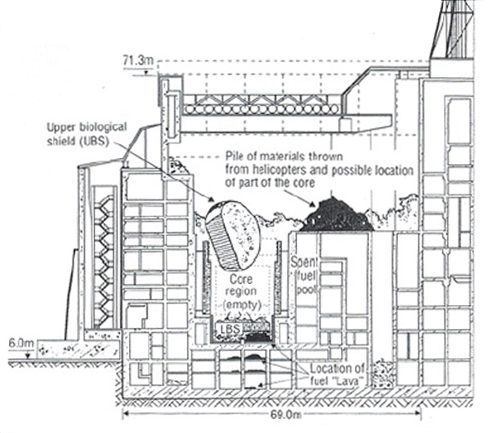
Home Page Previous Page Next Page
Beginning of the test
At 01h23mn04s, the remaining turbine is disconnected and its inertial energy feeds 4 of the 8 main pumps. As the turbine slows, the pumps also turn more slowly, and the water, moving more slowly in the core, begins to boil. Twenty seconds later, the power begins to increase slowly, then faster and at 01h23mn40s, an operator pressed the button to activate the drop of emergency stop rods and shut down the reactor. It is not known why he did that, he was one of the first victims. The water in the core, replaced by the graphite "displacers" set at the lower end of the rods causes a sharp peak of power. In four seconds, the peak of power reaches about a hundred times the rated power and destroys the reactor.
The sudden increase in power causes a sudden release of heat in the fuel rods which break into multiple pieces. The heat generated by these factors causes a rapid boiling of the cooling water and a lot of pressure pipes bursts under duress. The steam, escaped from the pressure tubes, breaks the steel container around the graphite and blows the concrete shield at the top of the reactor. The heavy slab flies, thus breaking the last pressure tubes which are still attached.

The reactor after the accident and the bombing with
absorbent materials
(Boron, sand, dolomite ...)
The sudden release of steam destroys the entire upper part of the building. The heavy slab then falls askew into the reactor, it is always there. The walls around are destroyed. The graphite and the fission products are projected very high by the blast of the explosion (the number of one thousand meters has been evocated). The heavy materials fall down just around the plant, including on the roof of the reactor No. 3 in east and on the roof of the turbines hall in south, and the graphite, ignited by the contact with oxygen in the air, lights up thirty fires around the destroyed reactor. The fission products, lighter, are swept away by the wind toward the northwest.
After the explosion
The first firemen to intervene are 14 firefighters Pripyat who arrive quickly on the scene, before 01:30 and are reinforced by other firemen from Pripyat assigned to the site and those from other nearby fire stations, until 250 firemen participate, in the night, to fight the fire and the damage caused to the nuclear power plant. They handled fairly quickly the fires lit by the graphite ejected from the reactor, on the roof of the turbines hall and then on the roof of the reactor No. 3. Around 5 am, the surrounding fires are extinguished. But during that fire fighting, the graphite in the reactor itself has ignited, and it became the most important source of dispersion of radioactive particles into the atmosphere during the days that followed.
These brave firefighters, conscious or not of the nuclear risk, were intensely irradiated by radioactive particles, for hours, during this fight against the fire. Many of them died shortly after the accident, those who survived were severely disabled.
Then, the serious problem that arose was the combustion of 600 tons of graphite in the damaged reactor core.
The Soviets used a fleet of helicopters to bombard the incandescent heart of the reactor with neutrons absorber materials. Approximately 5,000 tons of sand, clay, lead, boron and dolomite were thus thrown during 1,800 rotations carried out by helicopters. Initially, the helicopters were hovering over the crater of the reactor during the dropping of their load of absorbent materials, but it was too dangerous to stay above the reactor, and thus the charge was thrown during the passage of the helicopter.
This link provides access to a video showing the work of these pilots of helicopters: View Download
It was a delicate work to target the reactor from a helicopter in flight and, of course, a lot of loads sent during the passage of helicopters did not fall into the reactor core. The downside, if the materials participated in the absorption of the fission products, they covered the reactor and prevented its natural cooling causing a rise in the temperature which favored the release of radio nuclides.
It was also a dangerous work. The helicopter crossed directly the the flow of radioactive particles from the reactor and many of these brave pilots died thereafter. On May 6, the radiation emission stopped.